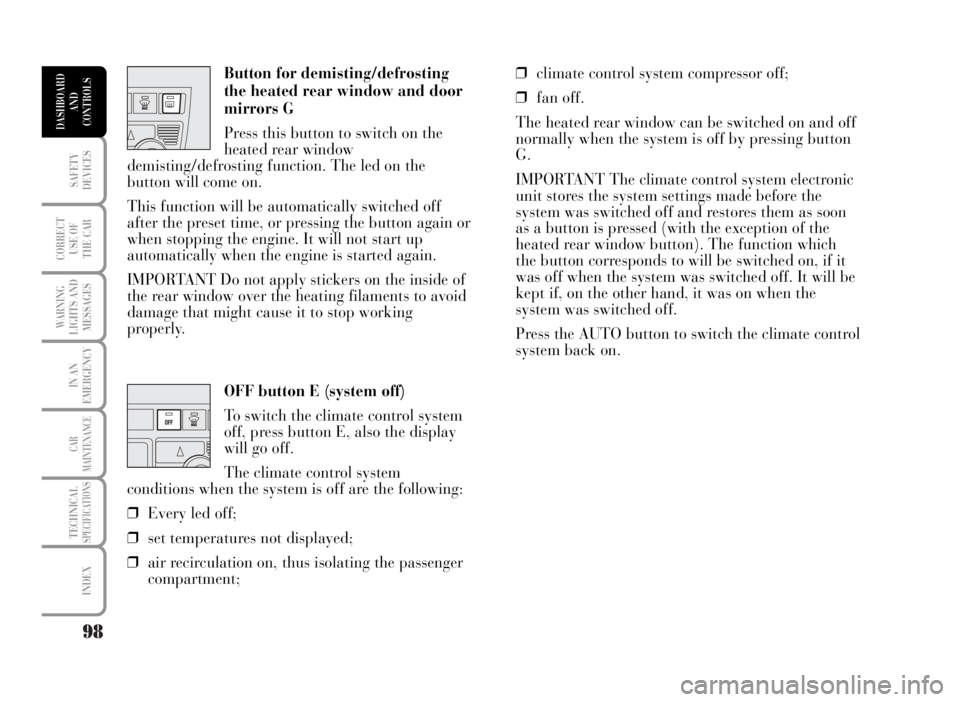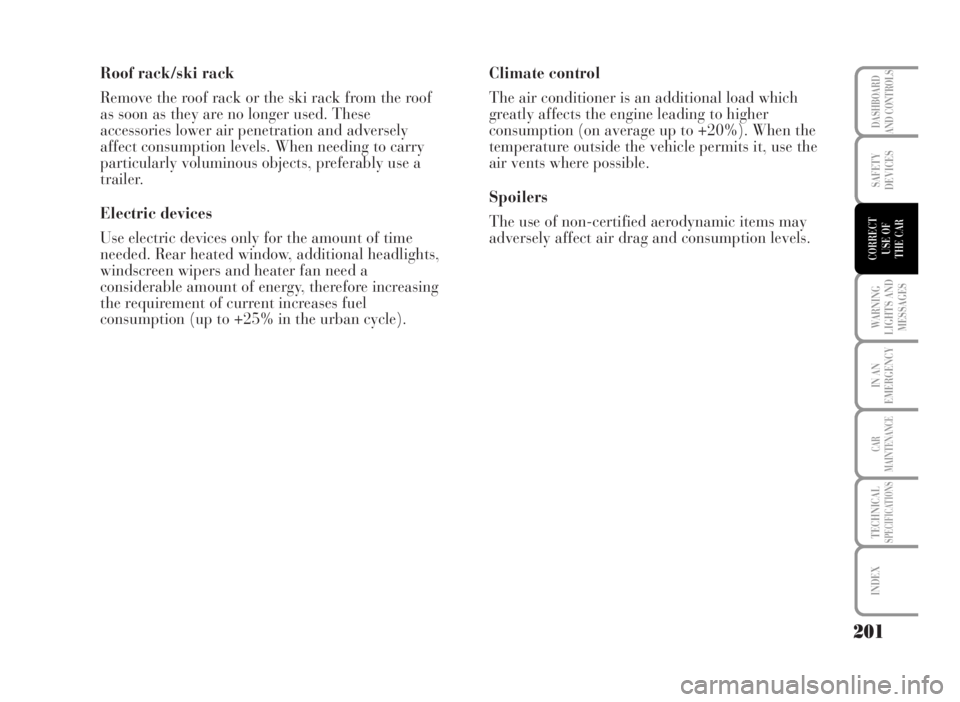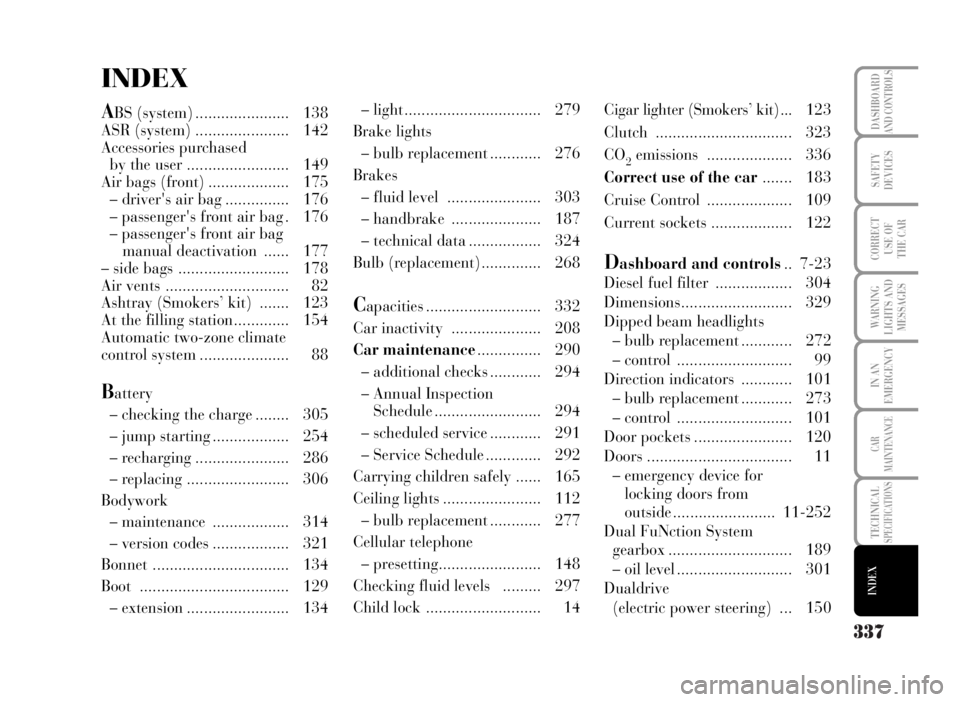climate control Lancia Musa 2007 Owner handbook (in English)
[x] Cancel search | Manufacturer: LANCIA, Model Year: 2007, Model line: Musa, Model: Lancia Musa 2007Pages: 346, PDF Size: 5.15 MB
Page 99 of 346

98
SAFETY
DEVICES
CORRECT
USE OF
THE CAR
WARNING
LIGHTS AND
MESSAGES
IN AN
EMERGENCY
CAR
MAINTENANCE
TECHNICALSPECIFICATIONS
INDEX
DASHBOARD
AND
CONTROLS
Button for demisting/defrosting
the heated rear window and door
mirrors G
Press this button to switch on the
heated rear window
demisting/defrosting function. The led on the
button will come on.
This function will be automatically switched off
after the preset time, or pressing the button again or
when stopping the engine. It will not start up
automatically when the engine is started again.
IMPORTANT Do not apply stickers on the inside of
the rear window over the heating filaments to avoid
damage that might cause it to stop working
properly.❒climate control system compressor off;
❒fan off.
The heated rear window can be switched on and off
normally when the system is off by pressing button
G.
IMPORTANT The climate control system electronic
unit stores the system settings made before the
system was switched off and restores them as soon
as a button is pressed (with the exception of the
heated rear window button). The function which
the button corresponds to will be switched on, if it
was off when the system was switched off. It will be
kept if, on the other hand, it was on when the
system was switched off.
Press the AUTO button to switch the climate control
system back on.
OFF button E (system off)
To switch the climate control system
off, press button E, also the display
will go off.
The climate control system
conditions when the system is off are the following:
❒Every led off;
❒set temperatures not displayed;
❒air recirculation on, thus isolating the passenger
compartment;
Page 202 of 346

Roof rack/ski rack
Remove the roof rack or the ski rack from the roof
as soon as they are no longer used. These
accessories lower air penetration and adversely
affect consumption levels. When needing to carry
particularly voluminous objects, preferably use a
trailer.
Electric devices
Use electric devices only for the amount of time
needed. Rear heated window, additional headlights,
windscreen wipers and heater fan need a
considerable amount of energy, therefore increasing
the requirement of current increases fuel
consumption (up to +25% in the urban cycle).Climate control
The air conditioner is an additional load which
greatly affects the engine leading to higher
consumption (on average up to +20%). When the
temperature outside the vehicle permits it, use the
air vents where possible.
Spoilers
The use of non-certified aerodynamic items may
adversely affect air drag and consumption levels.
201
WARNING
LIGHTS AND
MESSAGES
IN AN
EMERGENCY
CAR
MAINTENANCE
TECHNICALSPECIFICATIONS
INDEX
DASHBOARD
AND CONTROLS
SAFETY
DEVICES
CORRECT
USE OF
THE CAR
Page 285 of 346

284
WARNING
LIGHTS AND
MESSAGES
CAR
MAINTENANCE
TECHNICALSPECIFICATIONS
INDEX
DASHBOARD
AND CONTROLS
SAFETY
DEVICES
CORRECT
USE OF
THE CAR
IN AN
EMERGENCY
Fuse box in engine compartment
USERFUSE AMPERE
Dashboard control unit 1F1 70
Power steering control unitF2 70
Ignition switchF3 20
Dashboard control unit 2F4 50
ABS / ESP control unitF5 60
Radiator electric fan (low speed) (all versions)F6 30
Radiator electric fan (high speed) (all versions excluded 1.4 16V heated) F7 40
Climate control electric fanF8 30
Headlight washerF9 20
HornF10 15
Electronic injection secondary servicesF11 15
Right main beam headlightF14 10
Left main beam headlightF15 10
Electronic injection primary servicesF17 10
+30 Engine control unit / Radiator electric fan remote control switch (1.9 Multijet) (*) F18 7,5
CompressorF19 7,5
Heated diesel oil filter (Multijet)F20 30
Fuel pumpF21 15
Electronic injection primary services (1.4 16V)F22 15
Electronic injection primary services (Multijet)F22 20
Dual FuNction System gearbox oil pumpF23 15
Dual FuNction System gearbox fuse box power supply (+ key) F16 7,5
+15 Electric power steering (*)F24 7,5
Front fog lightsF30 15
(*) +30 = battery directive positive terminal (not under key)
+15 = positive terminal under key
Page 294 of 346

293
WARNING
LIGHTS AND
MESSAGES
TECHNICALSPECIFICATIONS
INDEX
DASHBOARD
AND CONTROLS
SAFETY
DEVICES
CORRECT
USE OF
THE CAR
IN AN
EMERGENCY
CAR
MAINTENANCE
Thousands of km
Check and adjust handbrake lever stroke
Check exhaust emissions/smoke
(1.3 Multijet and 1.9 Multijet versions)
Check exhaust emissions (petrol versions)
Check antievaporation system (petrol versions)
Change fuel filter cartridge (“green filter”) (diesel versions)
Change air cleaner cartridge (petrol versions)
Change air cleaner cartridge (1.9 Multijet versions) (❏)
Top up fluids
(engine coolant, brakes, windscreen washer, battery, DFN etc.)
Check timing belt conditions (■)
Replace timing belt (*) (■)
Change spark plugs (petrol versions)
Check engine control system operation
(through diagnosis socket)
Change engine oil and oil filter (❏)
Change engine oil and oil filter (Multijet version with DPF) (**)
Change brake fluid (or every 2 years)
Change pollen filter (or every year)
(*) Or every 4 years for particularly demanding use:
- cold/hot climates;
- driving in the city idling for a long time;
- dusty roads or roads covered with sand and/or salt
Or every 5 years, regardless of the km covered and conditions of use.
(**) Engine oil and oil filter shall be changed when the corresponding warning light turns on (see section “Warning lights and Messages”),
or in any case every 2 years.
(
❏) Every 30.000 km for 1.3 Multijet versions
(
■) Excluding 1.3 Multijet versions
20 40 60 80 100 120 140 160 180
●● ● ●
●● ● ●
●● ● ●
●●
●●●
●●●
●●●●● ●●●●
●●●●● ●●●●
●●
●
●● ● ●
●● ● ●
●●●●● ●●●●
(●)(●)(●)(●)(●)(●)(●)(●)(●)
●●●
●●●●● ●●●●
Page 297 of 346

IMPORTANT - Battery
The charge in the battery should be checked at the
start of winter to limit the risk of electrolyte
freezing.This check should be carried out more frequently if
the car is used mainly for short trips, or if it is fitted
with accessories that permanently absorb electricity
even with the ignition key removed, especially in the
case of after market accessories. If the car is used in
hot climates or particularly harsh conditions it is
wise to check the level of the battery fluid
(electrolyte) more frequently than specified in the
“Service schedule” in this section.
296
WARNING
LIGHTS AND
MESSAGES
TECHNICALSPECIFICATIONS
INDEX
DASHBOARD
AND CONTROLS
SAFETY
DEVICES
CORRECT
USE OF
THE CAR
IN AN
EMERGENCY
CAR
MAINTENANCE
Car maintenance should be entrusted to Lancia Dealership. For routine and minor maintenance
operations you wish to carry out yourself, always make sure you have the proper equipment,
genuine Lancia spare parts and the necessary fluids; do not however carry out these operations if
you have no experience.
Page 315 of 346

314
WARNING
LIGHTS AND
MESSAGES
TECHNICALSPECIFICATIONS
INDEX
DASHBOARD
AND CONTROLS
SAFETY
DEVICES
CORRECT
USE OF
THE CAR
IN AN
EMERGENCY
CAR
MAINTENANCE
BODYWORK
PROTECTION FROM ATMOSPHERIC AGENTS
The main causes of corrosion are the following:
❒atmospheric pollution;
❒salty air and humidity (coastal areas, or hot
humid climates);
❒seasonal environment conditions.
Not to be underestimated is also the abrasive action
of wind-borne atmospheric dust and sand and mud
and gravel raised by other vehicles.
Lancia implemented the best manufacturing
technologies to effectively protect the bodywork
against corrosion.These include:
❒Painting products and systems which give the
car particular resistance to corrosion and
abrasion;
❒Use of galvanised (or pretreated) steel sheets,
with high resistance to corrosion;
❒Spraying of plastic parts, with a protective
function, in the more exposed points: underdoor,
inner fender parts, edges, etc.;
❒Use of “open” boxed sections to prevent
condensation and pockets of moisture from
triggering rust inside.
BODY AND UNDERBODY
WARRANTY
Your Lancia Idea is covered by warranty against
perforation due to rust of any original element of
the structure or body. For the general terms of this
warranty, refer to “Warranty Booklet”.
Page 336 of 346

FUEL CONSUMPTION
The fuel consumption figures given in the table below are determined on the basis of the homologation tests set
down by specific European Directives.
The procedures below are followed for measuring consumption:
❒urban cycle: cold starting followed by driving that simulates urban use of the car;
❒extra-urban cycle: frequent accelerating in all gears, simulating extraurban use of the car; the speed varies
between 0 and 120 km/h;
❒combined consumption: is calculated weighing about 37% of urban cycle consumption and about 63% of
extraurban consumption.
IMPORTANT The type of route, traffic situations, weather conditions, driving style, general conditions of the
car, trim level/equipment/accessories, load, climate control system, roof rack, other situations that affect air
drag may lead to different fuel consumption levels than those measured.
Fuel consumption according to Directive 1999/100/EC (litres x 100 km)Urban Extra-urban Combined
1.48V(◊7.9 5.2 6.2
1.416V(5 gears) 8.5 5.5 6.6
1.416V(6 gears) 8.7 5.4 6.6
1.416VDual FuNction System 8.3 5.4 6.4
1.3 Multijet 70HP 6.2 4.5 5.1
1.3 Multijet 90HP 6.0 4.0 4.7
1.3 Multijet 70 HP Dual FuNction System 6.0 4.4 5.0
1.3 Multijet 90 HP Dual FuNction System 5.8 3.9 4.6
1.9 Multijet 6,5 4.4 5.2
(◊) Engine model provided for certain versions/markets only
335
WARNING
LIGHTS AND
MESSAGES
INDEX
DASHBOARDAND CONTROLS
SAFETY
DEVICES
ACORRECT
USE OF
THE CAR
IN AN
EMERGENCY
CAR
MAINTENANCE
TECHNICALSPECIFICATIONS
Page 338 of 346

337
SAFETY
DEVICES
CORRECT
USE OF
THE CAR
WARNING
LIGHTS AND
MESSAGES
IN AN
EMERGENCY
CAR
MAINTENANCE
TECHNICALSPECIFICATIONS
DASHBOARDAND CONTROLS
INDEX
INDEX
ABS (system) ...................... 138
ASR (system) ...................... 142
Accessories purchased
by the user ........................ 149
Air bags (front) ................... 175
– driver's air bag ............... 176
– passenger's front air bag . 176
– passenger's front air bag
manual deactivation ...... 177
– side bags .......................... 178
Air vents ............................. 82
Ashtray (Smokers’ kit) ....... 123
At the filling station............. 154
Automatic two-zone climate
control system ..................... 88
Battery
– checking the charge ........ 305
– jump starting .................. 254
– recharging ...................... 286
– replacing ........................ 306
Bodywork
– maintenance .................. 314
– version codes .................. 321
Bonnet ................................ 134
Boot ................................... 129
– extension ........................ 134– light ................................ 279
Brake lights
– bulb replacement ............ 276
Brakes
– fluid level ...................... 303
– handbrake ..................... 187
– technical data ................. 324
Bulb (replacement).............. 268
Capacities ........................... 332
Car inactivity ..................... 208
Car maintenance............... 290
– additional checks ............ 294
– Annual Inspection
Schedule ......................... 294
– scheduled service ............ 291
– Service Schedule ............. 292
Carrying children safely ...... 165
Ceiling lights ....................... 112
– bulb replacement ............ 277
Cellular telephone
– presetting........................ 148
Checking fluid levels ......... 297
Child lock ........................... 14Cigar lighter (Smokers’ kit) ... 123
Clutch ................................ 323
CO
2emissions .................... 336
Correct use of the car ....... 183
Cruise Control .................... 109
Current sockets ................... 122
Dashboard and controls.. 7-23
Diesel fuel filter .................. 304
Dimensions.......................... 329
Dipped beam headlights
– bulb replacement ............ 272
– control ........................... 99
Direction indicators ............ 101
– bulb replacement ............ 273
– control ........................... 101
Door pockets ....................... 120
Doors .................................. 11
– emergency device for
locking doors from
outside ........................ 11-252
Dual FuNction System
gearbox ............................. 189
– oil level ........................... 301
Dualdrive
(electric power steering) ... 150
Page 340 of 346

339
SAFETY
DEVICES
CORRECT
USE OF
THE CAR
WARNING
LIGHTS AND
MESSAGES
IN AN
EMERGENCY
CAR
MAINTENANCE
TECHNICALSPECIFICATIONS
DASHBOARDAND CONTROLS
INDEX
– flashing .......................... 100
Manual climate control
system .............................. 83
Mechanical gearbox (use) .... 188
Multifunction display .......... 37
– controls........................... 38
Number plate light
– bulb replacement ........... 277
Oddment compartments ..... 119
– upper .............................. 118
Outlets ................................ 122
Parking ............................. 187
Parking sensors ................... 152
Performance ........................ 330
Plates ................................. 319
Power windows ................... 126
Pretensioners ....................... 162
Prolonged car inactivity ...... 208
Protecting the environment.. 156
Radio transmitters and
cellular telephones ............. 148
Rain sensor ......................... 106Rear fog lights
– bulb replacement ............ 276
– control button ................. 116
Rear window washer
– control ........................... 108
– fluid level ...................... 302
Rear window wipers
– blades ............................ 311
– control ........................... 104
– nozzles ............................ 313
– smart washing ................ 105
Rearview mirrors ................. 79
Rev counter ......................... 27
Reversing light
– bulb replacement ............ 275
Rims and tyres .................... 325
Roof racks ......................... 136
Rubber tubing ..................... 311
Safety devices................... 157
Seat belts
– general instructions ....... 163
– height adjustment .......... 160
– maintenance .................. 165
– S.B.R. system .................. 159
– use ............................ 158-160Seats ................................... 70
Side bags ............................ 178
Side/taillights
– bulb replacement ....... 274-275
– control ........................... 99
Smart washing .................... 105
Snow chains ....................... 207
Sound system
– installation .................... 147
– preset system ................. 147
Spark plugs ......................... 322
Speedometer........................ 27
Starting the engine
– bump starting ................. 255
– emergency start-up ......... 253
– ignition switch ............... 22
– jump starting ................. 254
– JTD engines .................... 184
– petrol engines ................ 184
– stopping the engine ......... 186
– warming up the engine .. 186
Steering ............................... 324
Steering lock ...................... 22
Steering wheel (adjustment) 69
Sunroof ............................... 124
Sun visors ........................... 123